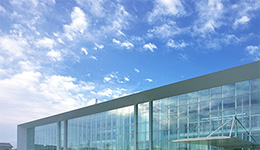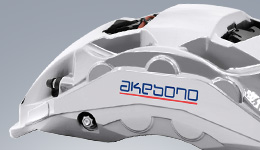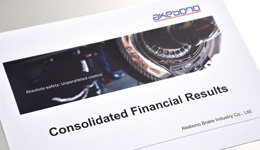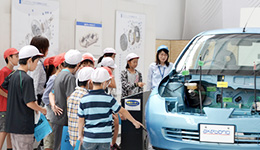Environmental Management
Promotion of Environmental Conservation Efforts Together with the Global Environmental Committee
ISO 14001 Certification Status and Scope
In June 1997, the Akebono Brake Group declared its "zero waste challenge" and positioned ISO14001 as a basic tool for environmental management in the company, and has worked diligently to obtain certification.
In 1999, Miharu plant (closed in 2011) became the first plant in our company to obtain ISO14001 certification by promoting energy-saving production and waste reduction. Then, Fukushima plant (currently Akebono Brake Fukushima Manufacturing Co., Ltd.), Akebono Brake Yamagata Manufacturing Co., Ltd., Sanyo Hydraulic Industry Co., Ltd. (currently Akebono Brake Sanyo Manufacturing Co., Ltd.), Akebono Brake Iwatsuki Manufacturing Co., Ltd. and Ai-City acquired ISO14001 certification in 2003 and ISO 14001 certification for all domestic sites was completed.
Audits of the environmental management system are conducted by external certification bodies for ISO 14001 certification renewal (every three years), external audits (annually), and internal audits conducted by in-house internal auditors (annually). Each domestic site reliably maintains the certification.
Each of our overseas sites is also actively pursuing certification.
ISO14001 Authentication Registration Application Range
| Authentication Registration Regional Division |
Certification Authority | Registered number | Initial Registration | Application Range | Location |
|---|---|---|---|---|---|
| Akebono Brake Industry Co., Ltd. Ai-City |
Japan Automobile Research Institute |
JAER0461 | Mar 29, 2003 | Headquarters Ai-Village Akebono 123 Co., Ltd. |
〒348-8508 5-4-71 Higashi, Hanyu-City, Saitama 348-8508, Japan |
| Akebono FRESH Center | 〒348-8501 5-8-3 Higashi, Hanyu-City, Saitama 348-8501, Japan |
||||
| Akebono Kids Care Co., Ltd. | 〒348-0052 5-8-4 Higashi, Hanyu-City, Saitama 348-0052, Japan |
||||
| Alocs Corporation (Packing) | 〒348-0064 1327-1 Jonuma, Fujiikamigumi, Hanyu-City, Saitama 348-0064, Japan |
||||
| Tatebayashi Foundry (Casting of brake components) | 〒374-0001 6012 Aza-Tobu Kogyo Danchi, Oshima-cho, Tatebayashi-City, Gunma 374-0001, Japan |
||||
| Ai-Ring (Testing and evaluation) | 〒979-3112 41-42 Aza-Kosaruda, Uwadaira, Ogawa-machi, Iwaki-City, Fukushima 979-3112, Japan |
||||
| Akebono Brake Yamagata Manufacturing Co., Ltd. |
Japan Automobile Research Institute |
JAER0162 | Mar 15, 2000 | Akebono Brake Yamagata Manufacturing Co., Ltd. | 〒991-0061 161-3 Chuo Kogyo Danchi, Sagae-City, Yamagata 991-0061, Japan |
| Akebono Brake Fukushima Manufacturing Co., Ltd. |
Japan Automobile Research Institute |
JAER0163 | Mar 15, 2000 | Akebono Brake Fukushima Manufacturing Co., Ltd. |
〒969-1652 10 Aza-Shinjuku, Oaza-Narita, Koori-machi, Date-gun, Fukushima 969-1652, Japan |
| Akebono Brake Iwatsuki Manufacturing Co., Ltd. |
Japan Automobile Research Institute |
JAER0349 | Mar 29,2002 | Iwatsuki area | 〒339-8601 1190 Oaza-Kanamuro, Iwatsuki-ku, Saitama-City, Saitama 339-8601, Japan |
Ainohara area | 〒339-0071 24 Ainohara, Iwatsuki-ku, Saitama-City, Saitama 339-0071, Japan |
Alocs Corporation | 〒339-0071 255-1 Ainohara, Iwatsuki-ku, Saitama-City, Saitama 339-0071, Japan |
| Akebono Brake Sanyo Manufacturing Co., Ltd. |
Lloyd’s Register Quality Assurance Limited |
10179566 | May 25, 2001 | Headquarter Kibi plant No.1 |
〒710-1201 1966-8 Kushiro, Soja-City, Okayama 710-1201, Japan |
| Kibi plant No.2 | 〒710-1201 1920-3 Kushiro, Soja-City, Okayama 710-1201, Japan |
Environmental Targets and Results
Each department establishes targets for each fiscal year based on medium-term environmental targets, then carries out environmental preservation initiatives aiming to meet the targets. To connect these with volunteer actions of individual associates, Akebono conducts ongoing education to promote awareness of individual roles in environmental preservation activities. The achievement of these measures is evaluated each fiscal year and reflected in improvements for the following fiscal year and beyond.
Targets for Fiscal 2021 and Results Achieved
| R&D | |
|---|---|
| Initiatives | |
| Promotion of products containing no substances of concern (SOCs) | |
| Medium- to long-term Targets | |
| Complete conversion to lead-free sintered material by 2025 (for local and bullet trains) | |
| Targets for Fiscal 2021 | |
| Lead-free sintered material production rate greater than 56% | |
| Results Achieved in Fiscal 2021 | |
| Lead-free sintered material production rate is 69% as of fiscal 2021 | |
| Plans for Fiscal 2022 and After | |
|
|
| Production | |
|---|---|
| 1 | Initiatives |
| Reduction of total CO2 emissions at production plants in Japan | |
| Medium- to long-term Targets | |
| FY2030: Reduce total CO2 emissions by 50% or more compared to FY2013 FY2050: Achieved carbon neutrality |
|
| Targets for Fiscal 2021 | |
| Targets have been set for each site with a view to reducing total CO2 emissions by 50% in FY2030 compared to FY2013 levels | |
| Results Achieved in Fiscal 2021 | |
| CO2 emissions increased 5.1% from the previous year due to an increase in the number of orders | |
| Plans for Fiscal 2022 and After | |
| Aim to reduce total CO2 emissions in FY2030 by 50% or more compared to FY2013 levels by continuing to promote energy conservation activities with the participation of all associates. | |
| 2 | Initiatives |
| Continue and improve ISO14001-related activities | |
| Medium- to long-term Targets | |
| Continue to enhance environmental activities | |
| Targets for Fiscal 2021 | |
| Firmly root ISO14001 in operations and steadily renew certifications | |
| Results Achieved in Fiscal 2021 | |
| Renewed the ISO14001 certifications | |
| Plans for Fiscal 2022 and After | |
| Continue to firmly root ISO14001 in operations and steadily renew certifications | |
| 3 | Initiatives |
| Promote no landfill waste disposal at production sites | |
| Medium- to long-term Targets | |
| Maintain and continue no direct landfill waste disposal | |
| Targets for Fiscal 2021 | |
| Continue no direct landfill waste disposal | |
| Results Achieved in Fiscal 2021 | |
| Continue no direct landfill waste disposal | |
| Plans for Fiscal 2022 and After | |
| Continue no direct landfill waste disposal | |
| Environmental Education | |
|---|---|
| Initiatives | |
| Environmental training for all associates | |
| Medium- to long-term Targets | |
| Develop human resources with a deep understanding of environmental activities and the ability to take the initiative | |
| Targets for Fiscal 2021 | |
| Development of environmental training | |
| Results Achieved in Fiscal 2021 | |
|
|
| Plans for Fiscal 2022 and After | |
| Enhanced and continued development of environmental training programs | |
| Logistics | |
|---|---|
| Initiatives | |
| Response to revised Energy Conservation Law (energy saving obligation of cargo owners) | |
| Medium- to long-term Targets | |
| Reduce unit energy consumption by 1% (five-year average) | |
| Targets for Fiscal 2021 | |
|
Reduce CO2 emissions by promoting more efficient transportation [Target values]
|
|
| Results Achieved in Fiscal 2021 | |
|
Improvement of loading efficiency through promotion of vehicle dispatch planning based on finalized information and Utilization of relay warehouses [Actual performance (compared to the previous year)]
|
|
| Plans for Fiscal 2022 and After | |
|
|
| Purchasing | |
|---|---|
| Initiatives | |
| Promotion of green purchasing | |
| Medium- to long-term Targets | |
| Establish structure that ensures purchasing activities in line with the Green Purchasing Guidelines | |
| Targets for Fiscal 2021 | |
| Revise supplier quality management (SQM) standard manuals | |
| Results Achieved in Fiscal 2021 | |
|
|
| Plans for Fiscal 2022 and After | |
|
|
| Production Engineering | |
|---|---|
| Initiatives | |
| Promotion of resource-saving designs | |
| Medium- to long-term Targets | |
| Develop manufacturing facilities and jigs that are reusable, achieving a greater yield ratio, energy saving, and eco-friendly operations with the aim of realizing environmentally friendly manufacturing | |
| Targets for Fiscal 2021 | |
| Further advancement and continues deepening design with good material yield and resource and energy saving technologies | |
| Results Achieved in Fiscal 2021 | |
|
|
| Plans for Fiscal 2022 and After | |
|
|
Refer to the following for performance data for each principal company.
- Akebono Environmental Data by Principal Company in Japan (PDF download 264 KB, 5 pages)*3
- *1 GADSL (Global Automotive Declarable Substance List)
A list of chemical substances requiring proper management formulated by automobile manufacturers, their parts suppliers and material suppliers in Japan, the United States and Europe. It is an industrywide standard targeting the following substances, which are possibly contained in parts and materials supplied to automotive manufacturers:
1. Substances that are subject to regulation under the laws of each country
2. Substances that are expected to come under legal regulation
3. Substances with a proven negative impact on health and/or the environment
The list contains substances classified into such categories as “Substances prohibited from use in all applications,” “Substances prohibited from use in certain applications or that must be declared if used” and “Substances that must be declared if usage exceeds defined threshold limits.” - *2 IMDS (International Material Data System): An international material data reporting system.
- *3 This link will be updated soon.







